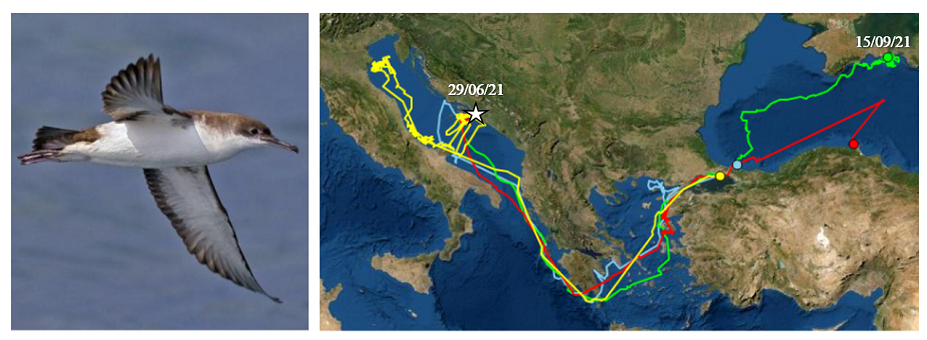CIESM Migratory Species Program
Seabirds, sharks and rays: sentinels of a fast-changing world |
|
Coordination:
Drs Loriane Mendez and Paula Moschella, CIESM
VISIT THE PROGRAM WEB PAGES
|
Seabirds - Sharks and rays ⇩
Background:
Seabirds in the Mediterranean are increasingly threatened by climate change, depletion of sea food resources, and other human related impacts (by-catch captures, artificial light pollution, habitat destruction). Although only few are considered critically endangered globally, in the Mediterranean and Black Sea region the situation is much different, whereby 25 species are listed in the Annex II List of Threatened and Endangered species of the SPA Protocol of the Barcelona Convention.
Spatial ecology:
Filling in major knowledge gaps in the geographic distribution and movements of seabirds in the Mediterranean and Black Sea Basins; identification of migration corridors and the interconnected breeding, foraging and wintering areas.

We began our investigations with the seasonal migration of the Yelkouan Shearwater (see photo) - a pelagic seabird endemic to the Mediterranean and Black Sea- on which so little is known. We equipped a dozen birds with extra-light satellite transmitters on a remote Croatian island. Half of them have embarked one by one on a long journey that ended mostly in the eastern Black Sea, in the vicinity of the Azov Sea - spawning grounds for millions of anchovies. Which raises dozens of questions, from the navigational tools used by a species that never flies overland, to the stimuli at the origin of their departure, to the migratory capacity of the juveniles - some of them also reaching the Black Sea after traveling at least 2600 km (see trajectories above).
The study of the Yelkouan migration is co-financed by a grant of the Prince Albert II Foundation for the period 2020-2024.
Atlas of Seabirds in the Mediterranean & adjacent Seas:
This Atlas includes all seabird species that:
- breed in the Mediterranean Sea and adjacent coasts (Atlantic Ocean till Portugal and Morocco, Black Sea);
- are capable of large movements (several hundred kilometers);
- rely mainly on the marine environment during their life cycle.
Plastic monitoring in seabirds nests:
Monitoring of marine litter in the nests of the European Shag (Phalacrocorax aristotelis). This species has the particularity to use marine litter collected at sea as nest-building material, which makes it most appropriate as an indicator of marine litter pollution in nearby coastal waters.
Participatory science:
Development of a user-friendly application ‘SeabirdWatchApp’ for fishermen so that they can easily share their observation of seabirds at sea, notably aggregations during fishing. They will have the choice to directly take a picture (date, time, latitude and longitude are automatically recorded by the smartphone) or to enter the observation manually.
Seabird Task Force:
• Albania: Taulant Bino, Albanian Ornith Soc., Tirana
• Algeria: Riadh Moulaï, Univ. of Bejaia
• Croatia: Sven Kapelj, Birdlife Croatia, Zagreb
• Greece: Georgios Karris, Ionian Univ., Zakynthos; Danae Portolou, Hellenic Ornith Soc., Athens
• Morocco: Sidi Imad Cherkaoui, École Sup. of Khenifra
• Portugal: Vitor H Paiva, MARE, Coimbra
• Spain: Daniel Oro, IMEDEA, Palma
• Tunisia: Abdessalem Hammouda, Univ Gabes, Zrig
• Turkey / Malta: Dilek Sahin, Bogazici Univ., Istanbul, Turkey (and BirdLife Malta)
Sharks & Rays
Background:
Most Mediterranean elasmobranchs are impacted by intense fishing pressure, either directly (trawling) or indirectly (bycatch). As a result, nearly half of sharks and rays species present in the Mediterranean Sea are classified as “Endangered” or “Threatened” in the IUCN Red List; a likely underestimate, in view of the paucity of data available.
CIESM initiative on missing sharks:
Some species have not been observed for a very long time in the Mediterranean Sea. This initiative invites visitors of our webpages to send any documented, reliable / verifiable evidence (published paper / Ph.D. thesis / photo) leading us to update shark records up to recent years. The observation of five species has already been documented since the launch of the initiative.

Spatial ecology:
Filling in major knowledge gaps in the geographic distribution and movements of sharks and rays in the Mediterranean and Black Sea Basins; identification of main migration corridors, starting with a pilot species.
More to come soon
Sharks & Rays Task Force:
• Albania: Rigers Bakiu, Tirana Agricultural Univ.
• Algeria: Farid Hemida, ENSSMAL, Alger
• Croatia: Alen Soldo, Univ. of Split
• Greece: Ioannis Giovos, iSea, Thessaloniki; Persefoni Megalofonou, Univ. of Athens
• Israel: Adi Barash, Haifa Univ.
• Italy: Fulvio Garibaldi, Genoa Univ.; Simone Panigada, Tethys Research Inst., Milano
• Libya: Esmail Shakman, Univ. of Tripoli
• Montenegro: Ilija Ćetković, Montenegro Univ.
• Portugal: Moura Teresa, IPMA, Lisbon
• Syria: Malek Fares Ali, Tishreen Univ., Lattakia
• Tunisia: Mohamed Nejmeddine Bradai, INSTM, Sfax
• Turkey: Nazli Kasapoglu, Fisheries Research Inst., Trabzon; Cemal Turan, Iskenderun Technical Univ.; Çiğdem Yigin, Çanakkale Onsekiz Mart Univ.
|
|



